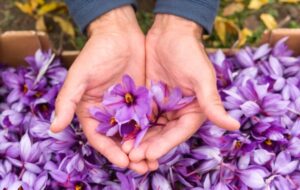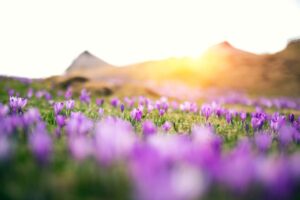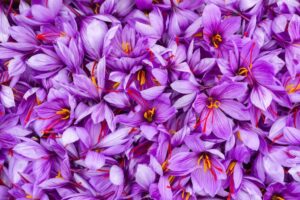Saffron, plant chemicals and medicinal properties[2023]
Saffron is a valuable medicinal food because of its importance in the agricultural economy of Iran. The dried stigmas of Crocus sativus (Iridaceae) are processed to produce saffron, a well-known spice that has other uses in the pharmaceutical, cosmetic, perfume and textile industries. Recently, reports of the medicinal effects of this plant have increased its importance in the world. The annual production of saffron in the world is estimated at 300 tons per year (76% of all saffron is produced in Iran), and saffron is considered the most expensive spice in the world.
Saffron chemicals and medicinal
That’s why they try to make it artificial or fake it. Thus, the quality safety of saffron must be confirmed in the international trade market in accordance with ISO or Food and Drug Administration (FDA) international standards. This article presents recent (or sometimes less documented) reports on the phytochemistry, pharmacology, and standard methods for quality assessment of saffron, a medicinal food spice.

Crocus sativus L. is a perennial spice plant (family Iridaceae) that is known as red gold in producing countries. This plant is the most expensive cultivated plant in the world. The root of the word saffron is the French word saffron, which comes from the Latin word saffron and the Arabic word meaning “yellow”. chemicals and medicinal
But this word is different from the old Persian word Kargam, which was used by the people around the Zagros mountains. It is documented that saffron was used in the court of the Achaemenid Empire as a food or spice for culinary purposes. The underground parts of the plant, tubers or bulbs, since this plant does not reproduce by seeds, can be used to produce a new plant. A characteristic feature of colourful saffron flowers is three stigmas (length 25-30 mm) hanging on the petals.
The flower also has three yellow stamens, which contain no active compounds and are usually not collected. Each bud produces from one to seven flowers. Cultivated species appear to have originated as a natural hybrid selected for long stigmas and maintained ever since.
C. The Sativa flower is pale purple in colour, but it is the thread-like red stigma of the flower that is valued as a natural spice and dye. It takes about 36,000 flowers to produce just one pound of stigma. More than 200,000 dried stigmas (derived from approximately 70,000 flowers) yield 500 grams of pure saffron (not tainted by saffron), which fetches $30 per ounce on the US market.
Check out our article on the How To Use Saffron For Weight Loss?
Traditional usage
Saffron is used in folk medicine and in the Ayurveda healing system as an analgesic, expectorant, antiasthmatic, and expectorant and apoptogenic agent. Saffron was used to preparing various opioids for pain (16th-19th centuries). The complete monographs of the German Commission E do not allow the use of this plant for spasms or asthma
Pharmacological activities
Clinical studies have been conducted to evaluate the efficacy of saffron in mild to moderate depression. Studies showed that saffron was more effective than placebo and at least equivalent to the therapeutic doses of imipramine and fluoxetine.
There were no significant differences in side effects in any of the studies. As a dietary supplement, saffron extracts can prevent retinal damage in rats and play a role in treating ischemic retinopathy and age-related macular degeneration. Anti-nociceptive and anti-inflammatory activities have been reported from saffron stigmas and petals.
A review of the literature showed that a decrease in cholesterol and triglyceride levels and a decrease in vascular damage were observed when hyperlipidemic rabbits were treated with crocetin.
Vascular hypoxia was also reduced. However, in another study, 400 mg/day (for 7 days) of saffron showed no effect on the lipid profile of healthy volunteers. Furthermore, an antioxidant effect was observed in human platelets along with inhibition of lipid peroxidation.
There is a report evaluating the potential role of saffron extracts in cancer therapy. However, saffron appears to be a selective cytotoxic plant, but the mechanism has not been clearly determined. Saffron is a medicinal and spicy plant notable for its powerful fragrance and its intense natural yellow colour.
Phytochemical studies have shown that the color is mainly due to the decomposed carotenoid compounds, crocin and crocetin, the taste derives from the oxidation products of the carotenoids, mainly safranal and the bitterness derives from the picrocrocin glycoside Pfander and Schurtenberger (1982) have suggested a proposal for biogenesis of active dyes and fragrances obtainable from the bio-oxidative cleavage of zeaxanthin.
Saffron chemicals and medicinal
Check out our article on the Is Saffron Uses For Skin Whitening?
chemicals and medicinal
The main principle of C. sativus is safranal, a volatile carboxaldehyde compound (70% of total volatiles), which is easily formed by deglucosylation of picrocrocin.
In addition to the above compounds, anthocyanins have been isolated from the blue flowers of C. sieberi and identified as 3,5-β-diglucosides of delphinidin and petunidin and from C. chrysanthus and identified as 3-β-rutinosides Furthermore, anthocyanins were isolated from the blue segments of the perianth of C. antalyensis and identified as delphinidin 3-O- (β-d-glucopyranoside) -5-O- (6-O- malonyl-β- d-glucopyranoside (10) and petudin 3,7-di-O- (β-d-glucopyranoside 3,7-di-O-β-d-glucoside of delphinidin 3,5-di-O-β -d-glucosides of delphinidin and petunidin

Appropriate season for picking Picking saffron flowers and isolating stigmas is not easy, and start right after the first flower appears in the field, as the flowers only stay for 3-4 days. If the flowers stay under hot weather and sunlight or wind, the quality of colour and smell will be changed and reduced.
The corresponding harvest season is modified and linked to the first watering. This season in Khorasan province starts from October to November. The flowering period is usually 15-25 days and the best time to sort is before sunrise. Appropriate picking method The picking of the flowers was carried out by the workers.
Plastic or wooden baskets are used for moving to avoid mechanical damage or contamination. The flowers must be opened by hand on the same day of harvest. If the flowers are opened before harvest, the stigmas may collapse or mix with the petals, and the quality will decline.
Drying methods Harvested saffron stigmas must be dried in order to preserve them for a long time. The drying method mainly affects the quality and cost of the product. In the traditional method, the stigmas are grouped into baskets, which contain thin holes, and then hung from the ceiling of a room at the right temperature.
If the colour of the stamps turns dark red and they squeeze between two fingers, the drying process comes to an end. This method takes a long time (about 1 week) and for this reason manufacturers sometimes place saffron under sunlight which darkens the product.
In recent years this system is gradually losing ground and electric ovens are used. Recently, an advanced drying method has been used, in which the scars are placed on the sterile silk net (150-200 g) with a layer 2-3 cm thick at a suitable distance from the oven (50-60 °C). With this method, the moisture of the products corresponds to the norm of 13%. Fast drying, high quality and less susceptible to air pollution and mold are further advantages.
Literature has shown that saffron samples from countries such as the UK, Iran and India have been compared against ISO/TS 332-1 values as chemical requirements for saffron samples. The results showed that the moisture content values of the samples from the three countries were close to the standard value; However, Indian saffron levels were slightly lower than others.
This could be explained by different drying methods in different countries as well as climatic differences.

Conclusion
Cuminum cyminum and Brassica napus are important medicinal food crops that are widely grown in Iran and are also grown for their nutritional purposes and economic importance.
The C. sativus plant is mainly distributed in the Irano-Turanian region and western Asia with low annual rainfall, cool winters and hot summers. Nowadays, saffron is grown in Iran and some countries with ancient civilization. Saffron is the most expensive spice in the world and its high price is due to the labor involved in growing, harvesting and handling it.
Production restrictions and strong consumer demand have resulted in a high price for saffron.
Saffron chemicals and medicinal
Check out our article on the How To Use Saffron For Face Glow?


![Saffron, plant chemicals and medicinal properties[2023]](https://www.saffronuses.com/wp-content/uploads/2022/09/saffron-benefits-0-750x430.jpg)